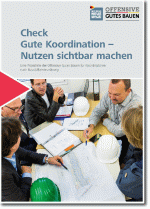There are many construction projects for which the coordinator has to draw up what is known as a safety and health plan (Sicherheits- und Gesundheitsschutzplan, SiGePlan).
The safety and health plan ensures the safety requirements for the works to be executed are understandable to all the parties involved in the construction project. The contents and form of safety and health plans are specified by Rule for Occupational Safety and Health on Construction Sites (Regel zum Arbeitsschutz auf Baustellen, RAB) 31.
Under Section 3(2) and (3) of the Construction Site Ordinance (Baustellenverordnung, BaustellV), the coordinator has to draw up a safety and health plan during the planning phase and update it during the execution phase.
A safety and health plan is necessary if:
- employees engaged by several employers work on the construction site simultaneously or successively
and - particularly hazardous work under Annex II of the Construction Site Ordinance is executed
or a prior notice is to be communicated, in other words - the amount of time required for the work exceeds 500 person days and/or
- the work is expected to take more than thirty days and more than twenty employees will be working on site simultaneously
Cross-trade risks are to be determined in the safety and health plan on the basis of the trade-related risks that have been identified. Cross-trade risks include:
- reciprocal risks caused by the exercise of several trades in the same location and at the same time
- reciprocal risks posed by a single trade
- common risks resulting from the local circumstances at the construction site
- common risks caused by third parties
Spatial and chronological allocation of activities
In order to avoid and/or reduce cross-trade risks, the coordinator has to stipulate appropriate measures and document them in the safety and health plan. The spatial and chronological allocation of activities plays an essential role in the coordination of the works. The safety and health plan sets out clearly for the parties involved in the construction project where works are to be executed and when they are scheduled. Apart from this, it provides them with information about the measures stipulated to ensure safe and healthy working and the relevant occupational safety and health provisions. In addition, RAB 31 contains further substantial recommendations that help the actors make effective use of safety and health plans.
It is often possible to implement occupational safety and health requirements economically for several trades with facilities in shared use. It also makes sense to give consideration to measures of this kind when the project’s execution is planned and service specifications, contracts, construction sequence plans and, where applicable, construction site regulations are drawn up.

